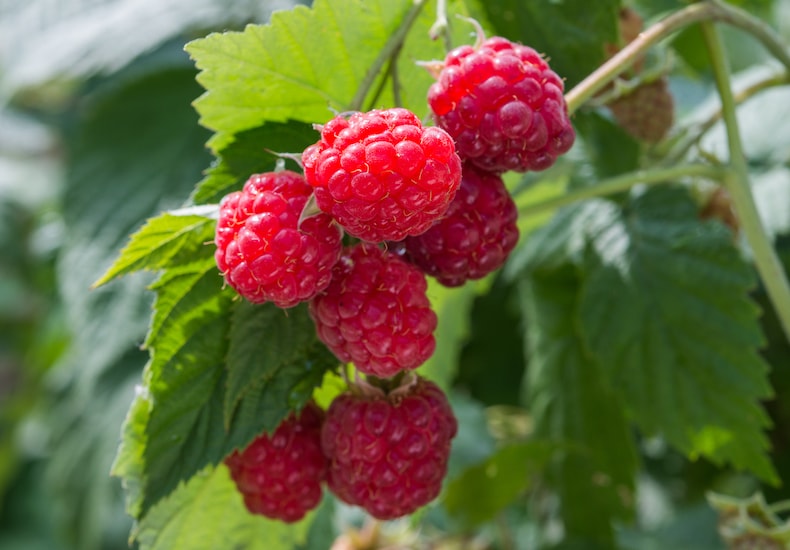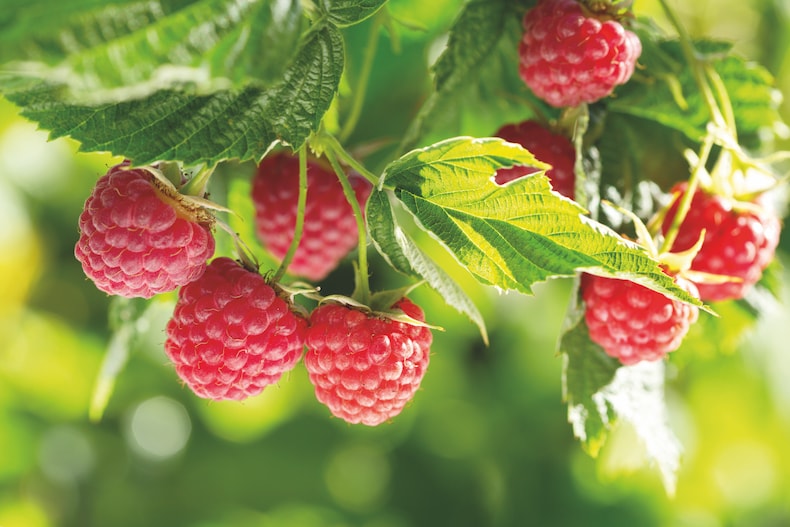
How to prune raspberries
Raspberry canes require regular pruning to maintain the size and quality of your crop. But how and when to prune your raspberry plants depends on whether you have a summer or autumn-fruiting variety. Armed with that knowledge, and a sharp pair of secateurs, here's Mandy Bradshaw's guide to pruning raspberries correctly.
Browse our full range of raspberry plants to find the best variety for your garden.
How and when to prune summer-fruiting raspberries

Summer fruiting varieties are easy to grow and maintain
Image: Raspberry 'Glen Ample' (Summer fruiting) from Thompson & Morgan
Summer fruiting raspberries are best planted between early autumn and late spring and should be pruned straight after planting. Cut the canes down to about 2.5cm in height, which will allow them to develop strong shoots.
Summer fruiting raspberries crop on the previous year’s wood so newly planted canes won’t produce fruit until their second year. Once you’ve harvested the berries, all the stems that bore fruit should be removed. Cut all the old wood to the ground – it’ll be dark brown – leaving the new green shoots to develop and fruit the following year. Removing the old wood encourages healthy new shoots to grow from the base, reinvigorating the plant.
Once your plants are established, it may be necessary to thin out some of this young wood to prevent the canes from becoming too congested. About 20cm apart is the perfect distance. Growing just a few strong canes produces a better crop than cultivating a lot of spindly stems that don’t get enough light.
It’s also a good idea to remove any weak growth and ‘runners’ that appear in the wrong place. Hoe these out rather than cutting or digging, which can encourage more shoots.
And check your plants after winter - you may need to remove any frost-damaged tips.
How and when to prune autumn-fruiting raspberries

Prune autumn fruiting varieties of raspberry in spring
Image: Raspberry 'Polka' (Autumn fruiting) from Thompson & Morgan
Autumn fruiting raspberry varieties flower and fruit in the same year, so they need to be pruned differently to summer raspberries.
Best planted over the winter when dormant, autumn fruiting raspberries should be pruned to the ground on planting. Once they have finished fruiting, you can cut all the canes down to the ground ready for new growth next spring.
If you live in a particularly cold part of the country, you might prefer to leave the canes alone after fruiting and wait until early spring. This prevents the risk of new growth being hit by frost. In spring, simply cut all the canes down to the ground to stimulate the new year’s growth, and remove any weak shoots.
The other benefit of spring pruning strong growing autumn varieties, is that it’s possible to get two different cropping times. Simply pruning a proportion of the canes to a height of 1m in early spring and the rest to the ground. Those that were pruned less severely will fruit in summer while the rest of the canes will produce raspberries as usual, in the autumn.
We hope this helps you to grow strong, healthy plants that produce bumper crops, year after year. For a quick recap, watch our video below.
You'll find more expert advice and top tips for caring for your own raspberries at our hub page, along with plenty of variety suggestions and our own tasty ranges.
See all pruning guides
Individual guides
Flower & Shrubs
- Pruning Buddleja
- Pruning Camellias
- Pruning Clematis
- Pruning Fuchsias
- Pruning Hydrangeas
- Pruning Hypercium - St Johns Wort
- Pruning Lavender
- Pruning Magnolias
- Pruning Passion Flowers
- Pruning Rhododendron
- Pruning Ribes Sanguineum
- Pruning Rosemary
- Pruning Roses
- Pruning Tree Peonies
- Pruning Wisteria
- Pruning Asparagus
- Pruning Blueberries
- Pruning Goji Berries
- Pruning Honeyberries
- Pruning Apple trees
- Pruning Box and Yew trees
- Pruning Catalpa trees
- Pruning Christmas trees
- Pruning Olive trees
- Pruning Patio Fruit trees
- Pruning Pear trees
- Pruning Plum trees
Fruit & Veg
Trees

Written by: Mandy Bradshaw, the Chatty Gardener
Cotswold-based Garden Media Guild member, Mandy Bradshaw, is also known as the Chatty Gardener. Passionate about gardening and writing, her beginnings are in football reporting for her primary school, and Mesembryanthemum planting with her mother. Winner of the 2018 Property Press Awards 'Garden Journalist of the Year', she writes for not only her own blog but also a range of newspapers, magazines and other gardening and non-gardening sites.Banner image: MP-Studio/ Shutterstock
Sign Up For Exclusive Special Offers




© 2025 Thompson & Morgan. All rights reserved. A division of Branded Garden Products Limited.



